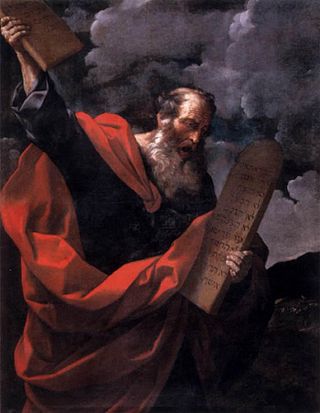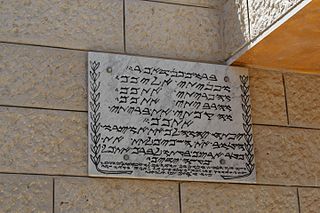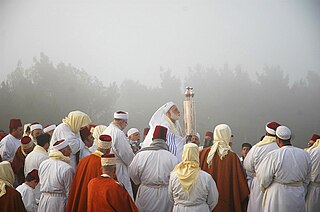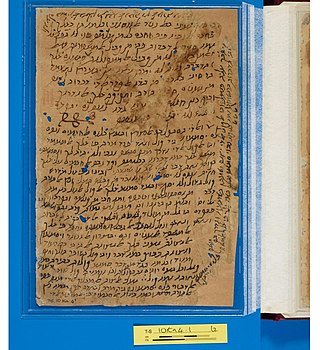Related Research Articles

According to Abrahamic religions, Aaron was a prophet, a high priest, and the elder brother of Moses. Information about Aaron comes exclusively from religious texts such as the Hebrew Bible, the New Testament, and the Quran.
Deuteronomy is the fifth book of the Torah, where it is called Devarim and the fifth book of the Christian Old Testament.
The Book of Genesis is the first book of the Hebrew Bible and the Christian Old Testament. Its Hebrew name is the same as its first word, Bereshit. Genesis is an account of the creation of the world, the early history of humanity, and the origins of the Jewish people.

Moses is considered the most important prophet in Judaism and one of the most important prophets in Christianity, Islam, the Druze faith, the Baháʼí Faith, and other Abrahamic religions. According to both the Bible and the Quran, Moses was the leader of the Israelites and lawgiver to whom the authorship, or "acquisition from heaven", of the Torah is attributed.

Samaritanism is the Abrahamic, monotheistic, ethnic religion of the Samaritan people, an ethnoreligious group who originate from the ancient Israelites. Its central holy text is the Samaritan Pentateuch, which Samaritans believe is the original, unchanged version of the Torah.

Samaritans, also known as Israelite Samaritans, are an ethnoreligious group who originate from the ancient Israelites. They are native to the Levant and adhere to Samaritanism, an Abrahamic ethnic religion similar to Judaism, but differing in several important aspects.

The Torah is the compilation of the first five books of the Hebrew Bible, namely the books of Genesis, Exodus, Leviticus, Numbers and Deuteronomy. The Torah is known as the Pentateuch or the Five Books of Moses by Christians. It is also known as the Written Torah in Jewish tradition. If meant for liturgic purposes, it takes the form of a Torah scroll. If in bound book form, it is called Chumash, and is usually printed with the rabbinic commentaries.

The Israelites were a group of Semitic-speaking tribes in the ancient Near East who, during the Iron Age, inhabited a part of Canaan.

The Samaritan Torah, commonly called the Samaritan Pentateuch, is a text of the Torah written in the Samaritan script and used as sacred scripture by the Samaritans. It dates back to one of the ancient versions of the Hebrew Bible that existed during the Second Temple period, and constitutes the entire biblical canon in Samaritanism.

The parable of the Good Samaritan is told by Jesus in the Gospel of Luke. It is about a traveler who is stripped of clothing, beaten, and left half dead alongside the road. First, a Jewish priest and then a Levite come by, but both avoid the man. Finally, a Samaritan happens upon the traveler. Although Samaritans and Jews were generally antagonistic towards each other, the Samaritan helps the injured man. Jesus is described as telling the parable in response to a provocative question from a lawyer, "And who is my neighbor?", in the context of the Great Commandment. The conclusion is that the neighbor figure in the parable is the one who shows mercy to their fellow man.

The Book of Jubilees, sometimes called Lesser Genesis (Leptogenesis), is an ancient Jewish apocryphal text of 50 chapters, considered canonical by the Ethiopian Orthodox Tewahedo Church as well as Ethiopian Jews, where it is known as the Book of Division. Jubilees is considered one of the pseudepigrapha by the Catholic, Eastern Orthodox, and Protestant Churches. It is also not considered canonical within Judaism outside of Beta Israel.

The Transfiguration of Jesus is an event described in the New Testament, where Jesus is transfigured and becomes radiant in glory upon a mountain. The Synoptic Gospels recount the occasion, and the Second Epistle of Peter also refers to it.

The Guide for the Perplexed is a work of Jewish theology by Maimonides. It seeks to reconcile Aristotelianism with Rabbinical Jewish theology by finding rational explanations for many events in the text.
The Book of Moses, dictated by Joseph Smith, is part of the scriptural canon for some denominations in the Latter Day Saint movement. The book begins with the "Visions of Moses", a prologue to the story of the creation and the fall of man, and continues with material corresponding to the Joseph Smith Translation of the Bible's (JST) first six chapters of the Book of Genesis, interrupted by two chapters of "extracts from the prophecy of Enoch".

The Ten Commandments, or the Decalogue, are a set of biblical principles relating to ethics and worship that play a fundamental role in Judaism, Christianity, and Islam. The text of the Ten Commandments appears twice in the Bible: at Exodus 20:2–17 and Deuteronomy 5:6–21.
The Desert of Paran or Wilderness of Paran, is a location mentioned in the Hebrew Bible. It is one of the places where the Israelites spent part of their 40 years of wandering after the Exodus, and was also a home to Ishmael, and a place of refuge for David.

Moses Gaster was a Romanian, later British scholar, the Hakham of the Spanish and Portuguese Jewish congregation, London, and a Hebrew and Romanian linguist. Moses Gaster was an active Zionist in Romania as well as in England, where in 1899 he helped establish the English Zionist Federation.
The Abrahamic religions are a group of religions, most notably Judaism, Christianity and Islam, centered around the worship of the God of Abraham. Abraham, a Hebrew patriarch, is extensively mentioned in the religious scriptures of the Hebrew and Christian Bibles, and the Quran.

The Transfiguration of Jesus has been an important subject in Christian art, above all in the Eastern church, some of whose most striking icons show the scene.
The Asaṭīr, also known as the Samaritan Book of the Secrets of Moses, is a collection of Samaritan Biblical legends, parallel to the Jewish Midrash, and which draws heavily upon oral traditions known among Jews in the 2nd and 3rd centuries CE. Moses Gaster places its compilation about the middle or end of the third century BCE, and rendered a translation of the work in 1927 with the Royal Asiatic Society in London. Others have said that its language style resembles more the Arabic language used by the scholar Ab Ḥisda [Isda] of Tyre in his poems of the eleventh century CE, and place its composition in the second-half of the tenth-century. The book's title, Asatir, was thought by Gaster to mean "secrets," from which name, he applied to the book its newer title, "The Secrets of Moses." Even so, such an interpretation has nothing to do with the contents of the book, nor with its subject. A more precise translation of the Arabic title of the work, al-Asāṭīr, would be "legends" or "tales," as in the Koranic expression asāṭīr al-Awwalīn.
References
- ↑ Memar Marqah. The Teaching of Marqah, edited and translated by John Macdonald. Vol. I, The Text, 177 pp.; Vol. II, The Translation, 255 pp. Beiheft zur Zeitschrift für die Alttestamentliche Wissenschaft, Nr. 84. Verlag Alfred Töpelmann, Berlin, 1963
- ↑ A. D. A. Moses Matthew's Transfiguration Story and Jewish-Christian Controversy 1850755760- 1996 "His departure is very much like an assumption or ascension story influenced by Sinai motifs and Sinai type cataclysmic happenings and language: 'All the powers descended on to Mount Nebo...the Glory drew near to him and embraced him' (Memar Marqah 5.3, p. 203). According to Memar Marqah 5.4, p. 207 'The shining light which abode on his face is with him in his tomb'. These examples show that the Moses-transfiguration theme plays an important role in Samaritan theology."
- 1 2 Tal, Abraham (2020). "Tibåt Mårqe: A New Edition with English Translation". Religions. 11 (1): 52. doi: 10.3390/rel11010052 . ISSN 2077-1444.